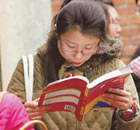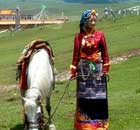Top Biz News
China's health safety net working, yet to be safer
(Xinhua)
Updated: 2010-03-08 13:14
 |
Large Medium Small |
In China, health security, or health safety net mainly consists of health insurance and medical assistance, and medical care for civil servants and employees of public institutions.
China now has a health safety net in place covering both urban and rural areas. Over the years, it prevented a lot of disease-afflicted families from sliding to poverty.
However, expensive health care still poses a grave social concern. In the lead up to the ongoing annual parliamentary and political advisory sessions, Chinese voiced their complaints on-line. According to statistics, medical care was among the top 3 concerns.
Professor Yang pointed out several drawbacks of the current health safety net.
Among other things, Yang said the reimbursement rate of the new rural corporative medical care system (NCMS) was too low to guard farmers against poverty.
At present, farmers pay 20 yuan a year to join NCMS, while government pay 80 yuan for each. According to such fund-pooling level, the reimbursement rate is usually around 30 percent, said Yang.
Low reimbursement rate has made NCMS less attractive. Grass-root health officials have to talk farmers into joining the scheme by a knock-on-door approach.
According to the Ministry of Health, 833 million farmers have joined NCMS by the end of 2009, 94 percent of the rural population.
For urban employees and the unemployed residents, the net looks not so safe either, because the reimbursement rate has a ceiling. If medical cost exceeds that ceiling, one has to pay by themselves, or apply for medical assistance.
"However, medical assistance is provided in a case-by-case manner, and there should be greater certainty," said Yang.
This has been addressed in Chinese Premier Wen Jiabao's Report on the Work of the Government Friday.
Wen said this year government's payment will increase from 80 to 120 yuan for each, by a 50 percent rise.
Besides, Wen said, pilot projects will be carried out to offer additional health security to rural kids suffering Leukemia and congenital heart disease.
"We will provide greater help to these unfortunate children and their families," vowed Wen.
Professor Yang also called for closing the existing gaps among several schemes tailored to different social groups.
In terms of the reimbursement rate, civil servants and employees of public institutions who enjoy public-funded medical care are 80 or 90 percent covered, urban employees are 70 percent covered, while that for farmers the lowest.
China has taken moves to level the health care ground.
Beijing has started pilot projects to reform health insurance system in government agencies and public institutions.
Beginning from January1, 2010, civil servants, employees of public institutions, schools and hospitals in Xicheng district will be covered by urban employee health insurance, rather than the previous public funded health-care.
|
||||
Yang said, "I hope health resources could be distributed fairly, so that health safety net could be 'safer' for the poor."
Shi Dazhuo, vice president of Xiyuan Hospital of China Academy of Chinese Medical Sciences, gave a B-plus when commenting on the current health reform, while attending the ongoing annual meeting of Chinese political advisors.
"After all, farmers go see doctors when they get ill because of the health security, while in the past medical bill would hold them back. Isn't it a tangible benefit?"












